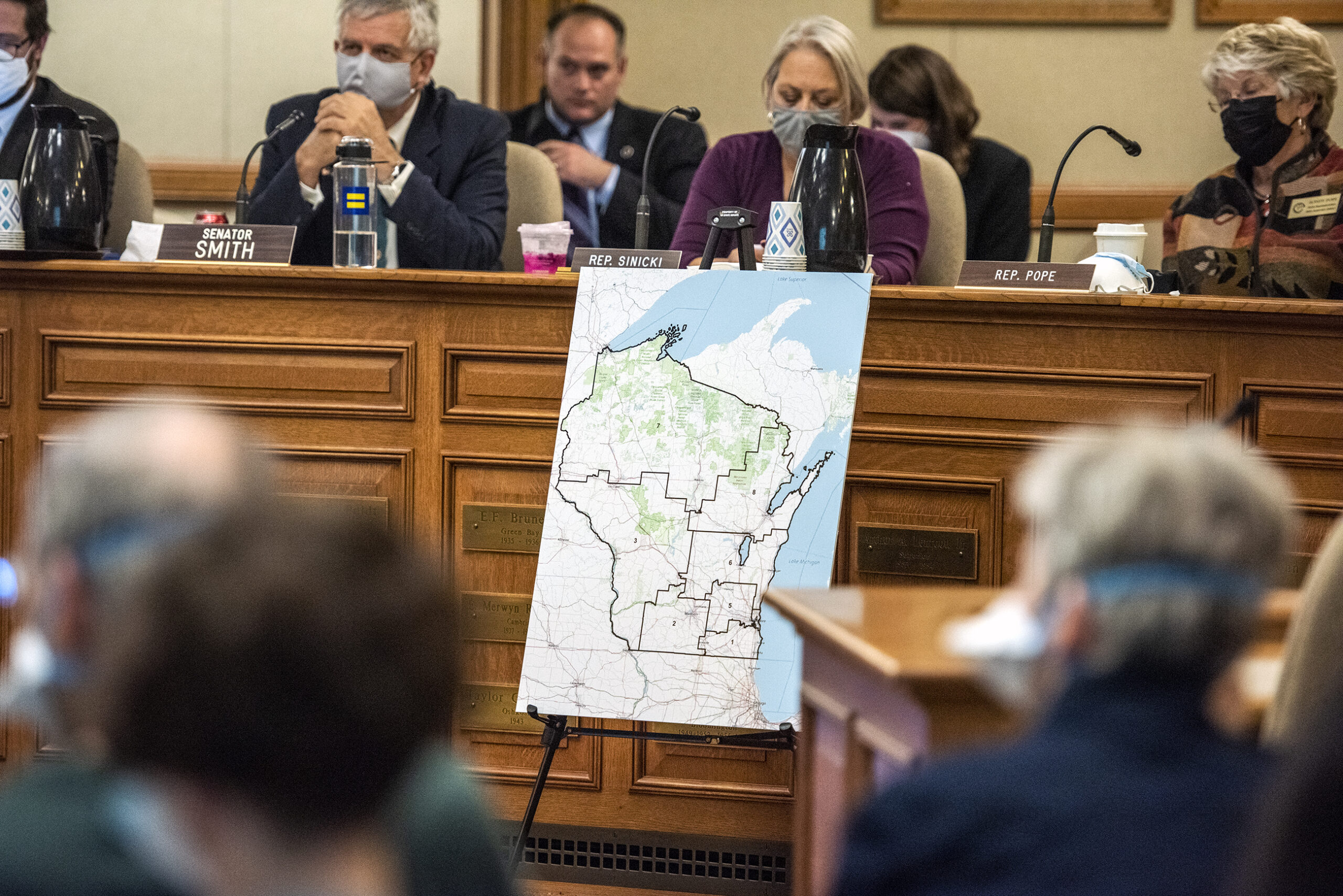If the 2022 election was held using new legislative voting maps proposed by parties to a state redistricting lawsuit, Republican lawmakers would be projected to maintain legislative majorities in almost every option.
But those majorities would shrink significantly under most proposals seeking to replace Republican-drawn maps struck down by the Wisconsin Supreme Court’s liberal majority.
Seven sets of state Assembly and state Senate map proposals were submitted to the court Friday. They came from the group of Democratic voters who filed the redistricting lawsuit, Gov. Tony Evers, the Republican-run state Legislature, Democratic state senators and the conservative Wisconsin Institute for Law and Liberty, or WILL. Also submitting maps were a group of Wisconsin mathematics and law professors and a UW-Milwaukee professor who created a redistricting algorithm called “FastMap.”
News with a little more humanity
WPR’s “Wisconsin Today” newsletter keeps you connected to the state you love without feeling overwhelmed. No paywall. No agenda. No corporate filter.
The map submissions will be analyzed by University of California, Irvine Political Scientist Bernard Grofman and Carnegie Mellon University Political Scientist Jonathan Cervas, who were hired as redistricting consultants by the court. They have until Feb. 1 to issue a report on their findings.
In the meantime, Marquette University Law School Lubar Center Research Fellow John Johnson created his own scorecard of the submissions. In order to provide an apples-to-apples comparison of the complex proposals, Johnson told WPR he used the court’s criteria for new maps included in its Dec. 22 ruling that struck down the current maps.
In that decision, liberal justices said they would evaluate new maps based on constitutional requirements that districts be compact, include similar populations and have boundaries that physically connect. Liberal justices also said they will also consider the “partisan impact” of any map submissions.
“And so I tried to come up with statistics to measure each one of those things,” Johnson said. “And as you can imagine, for most of those criteria, there’s many ways that you could measure it, many ways that are empirically valid. But the important thing is that you apply your measure uniformly to each plan.”
To do that, Johnson ran the maps data through a computer program using election data from the Nov. 2022 election.
Here’s how Johnson sees the various map proposals stacking up:
The governor’s maps reduce GOP majorities
In a theoretical rerun of the 2022 election using Gov. Evers’ proposed maps, Republicans would hold a 53-46 majority in the Assembly. In the state Senate, Republicans would have held a 17-16 majority if all other election data from 2022 were the same.
Under the current GOP maps, Republicans hold a 64-35 majority in the Assembly and a 22-11 majority in the Senate, leaving them just shy of having a veto proof majority in both chambers.

Democratic plaintiffs’ maps produce nearly 50-50 results
The proposed maps offering Republican’s the slimmest projected Assembly majority came from the Democratic voters who initiated the redistricting lawsuit in August.
Using Johnson’s analysis, their map is projected to give Republicans a 50-49 majority in the Assembly and a 17-16 majority in the Assembly.
Johnson’s numbers differ slightly from those submitted to the court by an expert hired by the plaintiffs, who projected a 52-47 GOP edge in the Assembly. That expert used a wider range of election results to arrive at his projection than Johnson did.
Maps from GOP lawmakers largely unchanged from 2022
Maps submitted by Republican lawmakers are projected to maintain overwhelming GOP majorities in both legislative chambers, according to Johnson’s analysis.
In fact, using 2022 election data, the GOP would win an additional state Senate seat, giving that party a 23-10 majority over Democrats. In the Assembly, Republicans would keep their current 64-35 majority.
A legal brief filed by GOP lawmakers refused to consider the court’s “partisan impact” requirement for new maps. Attorneys for the Legislature argued the only way for the court to ensure political neutrality when choosing new maps “is to stay out of politics altogether.”
Maps from Senate Democrats projected to give their party majority
Democratic state Senators who intervened in the redistricting case submitted maps projected to give their party an 18-15 majority in that chamber, according to Johnson. Republicans would still be projected to win the Assembly with a 53-46 majority.
In technical notes, Johnson noted Senate Democrats’ proposed map includes two districts “with disconnected portions,” according to U.S. Census data. That’s potentially significant because contiguity is the issue that the Supreme Court’s liberal majority used as justification to strike down the old Republican-drawn maps.

WILL maps projected to largely preserve GOP majorities
Maps submitted by the conservative Wisconsin Institute for Law and Liberty, which is representing Republicans who also intervened in the state’s last redistricting court battle, would be projected to reduce Republican power in the Legislature, but only slightly.
In the Assembly, the GOP would be projected to hold a 60-39 majority under Johnson’s analysis, down from 64-35 right now. In the Senate, Republicans would be projected to hold a 22-11 majority, the same number of seats they have under the current map.
‘FastMap’ plan gives Democrats small edge in Senate
Universities of Wisconsin-Milwaukee Professor Matthew Petering, who runs the redistricting consulting company “FastMap,” submitted maps as well.
Johnson’s analysis found Petering’s Assembly map proposal is projected to give Republicans a 52-47 seat majority using 2022 data.
But in the state Senate, Petering’s map proposal would give Democrats a one-seat majority of 17-16.
Maps from professors create narrow GOP majorities
A group of university law and mathematics professors, referred to in the redistricting lawsuit as the Wright petitioners, also submitted map proposals. In the Assembly, the Wright maps would give Republican’s a projected 51-48 majority. In the Senate, Republicans would hold a 17-16 majority.
2024 will ‘have a different electorate’
Johnson said while his model shows an even-handed comparison of all of the map proposals, it’s important to recognize Wisconsin’s election this fall will be notably different than the one held November 2022.
“It’s going to have a different electorate,” Johnson said.
He said turnout will be higher in the presidential election, for starters. And if the Supreme Court redraws the maps, it could effect who is willing to run for the Legislature.
“If it’s a more competitive map, I think it’s quite likely that the Democratic Party would recruit new candidates and probably fund their campaigns better,” Johnson said.
Johnson also said it’s important to remember that while his model shows potential outcomes for the state Senate’s balance of power, it includes data for all 33 senate districts.
“The asterisk there is that only 16 or 17 seats are up at a time in the state Senate,” Johnson said. “So, it takes longer for that new map to take effect.”
When considering all of the court’s redistricting criteria, Johnson said there’s “no clear winner” out of the seven map proposals. Also, he said there aren’t clear guidelines for how those criteria — like compactness, ward splits and partisan impact — will be weighed by justices.
“So the justices have some judgment calls to make,” Johnson said, “about which of these criteria matter more than others.”
Wisconsin Public Radio, © Copyright 2026, Board of Regents of the University of Wisconsin System and Wisconsin Educational Communications Board.


